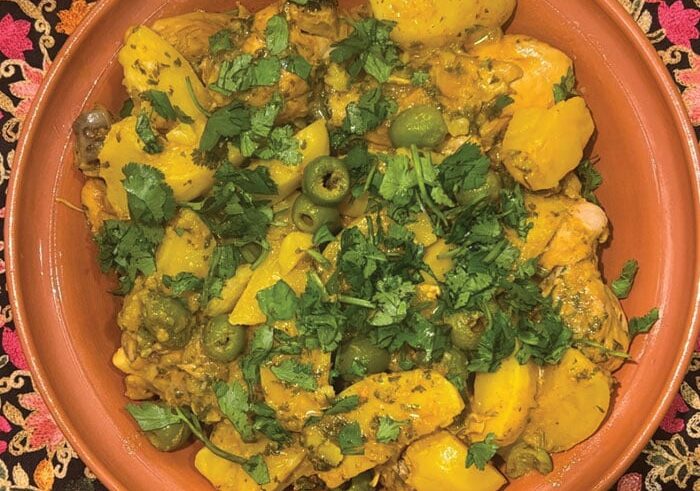
I have started taking stock of all the chametz in my house. The frozen challah in my freezer, the many snack bars and huge boxes of cereal I bought at Costco that my kids have stopped eating, and the Australian chocolate and biscuits that I have stashed in my bedside table. I’m desperately figuring out how to discreetly get rid of it all.
An indispensable ingredient in Moroccan cooking, preserved lemons add a unique, umami flavor to any fish, chicken or lamb tagine.
Rachel is ahead of the Passover game and has already started to preserve her kosher for Pesach lemons. An indispensable ingredient in Moroccan cooking, preserved lemons add a unique, umami flavor to any fish, chicken or lamb tagine. (They also add a burst of sunshine and perfect brine to any salad.) This week Rachel shares her mother’s mouthwatering chicken and olive tagine recipe. It is perfect for Pesach and all year round.
Now, a tagine is the traditional, distinctive, clay cooking vessel used in the North African kitchen. The circular base of the dish is wide and shallow and the tall conical lid fits inside. As the food simmers over the flame, the steam rises into the cone, then condenses, allowing the moisture to drip down the sides of the dish, resulting in a rich, slow-cooked, flavorful stew. But the good news is that you don’t need a tagine to make a tagine stew. Just use any heavy bottomed pot with a snug-fitting lid.
And the even better news for those of us still grappling with Passover cleaning, Rachel shares an easy hack for quick preserved lemon.
—Sharon
As a young bride, Moroccan lemon and olive chicken tagine was the first dish my mother taught me to make. It was the beloved recipe that she made every Friday night. In the first years of our marriage, I took the time to prepare chicken tagine. I lovingly marinated the chicken in a charmoula paste made of chopped herbs, preserved lemon and lots of spices. I braised the chicken in a bed of softened onion. And waited patiently for the chicken to simmer in the broth until it was so tender and juicy that it fell off the bone.
Then I became a working mom. I would do the Shabbat food shopping during my lunch break on Thursdays. And I would cook late into the night, after the kids went to bed. I would be at work by 8am the next day, my fingers yellow from cooking with turmeric. No one had a clue that I had been cooking and baking until 2 o’clock in the morning. In retrospect, I have no idea how I had the stamina.
I figured out that the cooking went faster and easier if I just roasted everything in the oven. So my mother’s recipe for tagine was transformed into a more simple, straightforward roasted chicken with lots of onion and potatoes smothered in a lemony Dijon mustard sauce. As my children got older and their palettes matured, I added olives.
I also began to make my own preserved lemons. And naturally, I was tempted to add them to the roasted lemony Dijon olive chicken. Imagine my thrill when I got the thumbs up from Neil and the kids!
Recently, I have been reminiscing about my mother’s cooking and all her wonderful recipes. I realized that almost everything she made was slow-cooked on the stove top, a cooking method that is described in Spanish as “A Comida.” And though my mother utilized the tagine method of cooking, she never actually owned an earthenware tagine.
My cousin Simy loves to cook with her tagine and she always encourages me to try cooking with one. I purchased my own treasured tagine at Walmart, but I rarely use it because of my fear that the flame will crack the pot. I recently bought a heat diffuser (a metal plate that sits between the flame and the pot), so let’s see if that gives me more confidence to use the tagine.
Now that I have more time in the kitchen, I have started slow cooking more of my chicken, meat and fish dishes. The resulting flavors are truly spectacular! The slow simmer tenderizes the proteins, softens the vegetables, melds the flavor of the spices and creates the most delicious sauce.
This is the way our grandmothers cooked and you can really feel (and taste) the love.
—Rachel
Maman’s Moroccan Lemon and Olive Chicken Tagine
1 medium chicken, cut into 8 pieces or
8 chicken thighs
1 generous pinch of saffron soaked for
10 minutes in 1 cup of warm water
Ingredients for Chicken Marinade
Pulp of 1 large preserved lemon, reserve
lemon skin for tagine
1/2 cup cilantro, finely chopped
1/2 cup Italian parsley, finely chopped
2 large garlic cloves, crushed
2 teaspoons sweet paprika
1 teaspoon ginger powder
1/2 teaspoon cumin
1/4 teaspoon of freshly ground black
pepper
2 tablespoons saffron water
2 tablespoons extra virgin olive oil
Marinating the chicken
In a large bowl, combine parsley, preserved lemon, garlic, paprika, ginger, cumin, pepper, saffron water and olive oil. Mix well.
Place the chicken in the bowl with the charmoula marinade and massage into the flesh.
Cover and refrigerate for at least 1 hour or overnight.
Ingredients for the Tagine
2 onions, finely grated
¼ cup extra virgin olive oil
½ teaspoon salt
1 teaspoon turmeric
1 tablespoon fresh lemon juice
8 medium golden potatoes, peeled and
quartered
1 cup canned green olives, rinsed and
drained
1 cup dry white wine
Skin of 1 preserved lemon, cut into strips
1/4 cup cilantro, roughly chopped plus
more for garnish
1/4 cup Italian parsley, roughly chopped
plus more for garnish
Warm the olive oil over medium heat in a Dutch oven or heavy pot, then add the onions.
Sprinkle salt and turmeric into the pot.
Place the chicken, skin down on top of the onions. Pour in any leftover marinade and add lemon juice.
Simmer for 15 to 20 minutes, until the liquids start to slowly bubble.
Flip the chicken pieces over, then add the potatoes and olives and stir well. Add the remaining saffron water and white wine and cover the pot.
Reduce the heat to low and simmer for 1 to 2 hours, until the chicken and potatoes are fork tender.
Uncover the pot and add the preserved lemon skin and fresh parsley and cilantro.
Continue cooking uncovered on low for 15 minutes until the liquid has evaporated and the sauce has thickened.
Taste sauce and add salt if necessary (the preserved lemons are already salty!)
Garnish with fresh cilantro and parsley.
Serve on a beautiful platter or straight out of the pot.
Quick Preserved Lemon
Preserved lemon is magical and is very simple to make. Pickling fresh lemons with kosher salt in a jar for 1 month yields incredible flavor. (Recipe on our website sephardicspicegirls.com.) But if you don’t have time, try this quick hack.
4 lemons, washed and dried
1/2 cup kosher salt
Slice lemons in 1/8 inch slices and remove any pits. Place in a bowl and cover thoroughly in kosher salt.
Place salted lemons in a freezer bag or tightly sealed container and freeze overnight.
Rachel Sheff and Sharon Gomperts have been friends since high school. They love cooking and sharing recipes. They have collaborated on Sephardic Educational Center projects and community cooking classes. Follow them on Instagram @sephardicspicegirls and on Facebook at Sephardic Spice SEC Food.

































